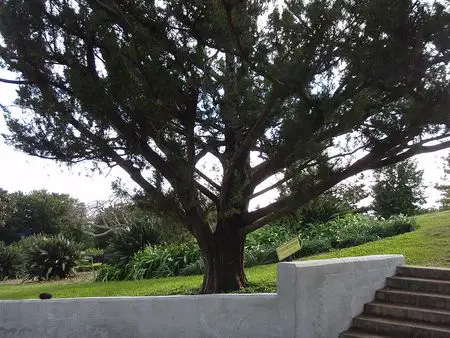Bermuda Cedar
Bermuda Cedar is genetically an endemic species which means it can not be found anywhere else in the world. Although there are other varieties that exist elsewhere, this species is unique to Bermuda and known as Juniperus Bermudiana.
Bermuda Cedar has had a long significance with the islanders right from the early settlement days. When the first settlers landed in Bermuda in early 1600s, they figured out that Bermuda was full of cedars. There were cedar concentration in many areas including in valleys, freshwater marshes and upland forests. In fact there were cedar forests with some 500 trees per acre of land. So Bermuda cedar soon became an integral part of the life of islanders. They used it virtually in everything including making home furnishings, floors, building churches and extensively in shipbuilding.
Bermuda Cedar at Botanical Gardens
Source: Wikimedia Commons
Between 17th and 18th centuries the Bermuda sloops had great demand all over the world and the logs from the Bermuda cedars were heavily used for making ships.
The cedar logs were even exported in large numbers to England in the 17th century until the administration put in place legislation to restrict such exports. The cedar also served as firewood and also used as local medicine. The Bermuda cedars are also known to repel moths and fleas thus making it excellent choice for furniture and other wooden crafts.
A Bermuda cedar tree when fully grown can be about 50-foot tall and have a 4-foot wide trunk. While growing, initially it has a cone shape and gradually becomes rounded when it becomes fully matured. It would have extensive roots below the soil and able to withstand storms and hurricanes. The branches are widely spread out and provide a great nesting place for many species of birds including the
Eastern Bluebirds. The twigs from where the leaves grow are square in cross-section. A healthy Bermuda cedar would go on to live for several hundred years.
Bermuda cedars are known for their exotic aroma that are sweeter than the other varieties found in the US. The red wood is harder and darker in color.
Between March and April, the Bermuda cedars flower. The males produce conical shaped yellow flowers that are filled with pollens. The females produce small flowers that become blue gray berries by September serving as great food for the birds.
However, in the 1940s and 1950s about 95% of the cedar plantation was destroyed by attacks from oyster shell scale and juniper scale insects or parasites.
Large number of cedars gradually died. During the 1950s, more than 75,000 dead Bermuda cedars were cut off and removed by the Government. Such mass-scale damage had a long term ripple effect in Bermuda's ecology which is still yet to recover fully from the shock. Some of the endemic species of animals that were heavily dependent on the cedar have become extinct like the Cicadas.
However, about 5% of the cedars were able to survive from the parasite attack. They were supposed to be resistant to such parasites. Today you won't find any Cedar forest or such concentration in Bermuda that used to exist once.
Bermuda government has been trying since 1980s to restore the cedar plantation in the island by implanting seeds from the resistant varieties. No wonder the cedar make items have become far more expensive these days and adorn the homes of wealthy and rich.
As a tourist, you can see Bermuda cedars in
Botanical Gardens in Paget Parish. A cedar sidling is often placed on top of the wedding cake during a Bermudian's marriage. This is later planted by the couple in their yard symbolizing love and bondage that would grow like the cedar.
|
 By Raj Bhattacharya By Raj Bhattacharya
Raj, a seasoned travel writer and Bermuda destination expert, has extensive global travel experience. This website reflects his profound insights, garnered over nearly two decades of dedicated findings and research on the island. Raj has assisted countless Bermuda-bound visitors by providing direct, personalized responses to their queries and imparting his wealth of knowledge through this platform. This site serves as an indispensable guide for those seeking informed and reliable insights into Bermuda's treasures.
|
Related Articles
|
Visitors' Reviews and Comments
Rosemary Daly (June 2016)
My husband and I have both been to Bermuda 2x (when we were younger). I have great memories of riding a moped through the island, going thru an area that had cedar trees ... any idea where that would be?? Thanks!
Raj (bermuda-attractions.com) June 2016
Cedar Avenue in Pembroke (near Hamilton) was once lined up with cedar trees on both sides. Although the original trees were mostly destroyed in 1950s and 60s by scale insects and parasite attacks, Bermuda government has re-planted cedars since 1980s, so you can still see some.
|

 By Raj Bhattacharya
By Raj Bhattacharya